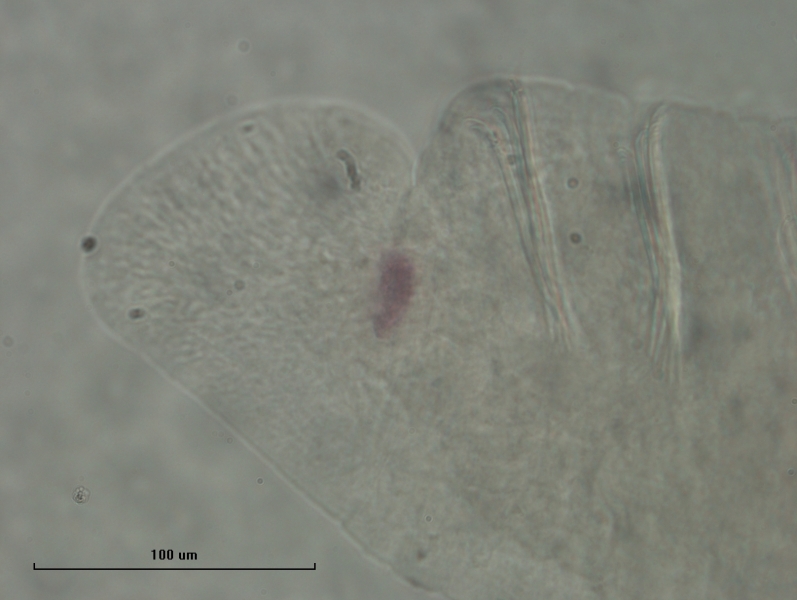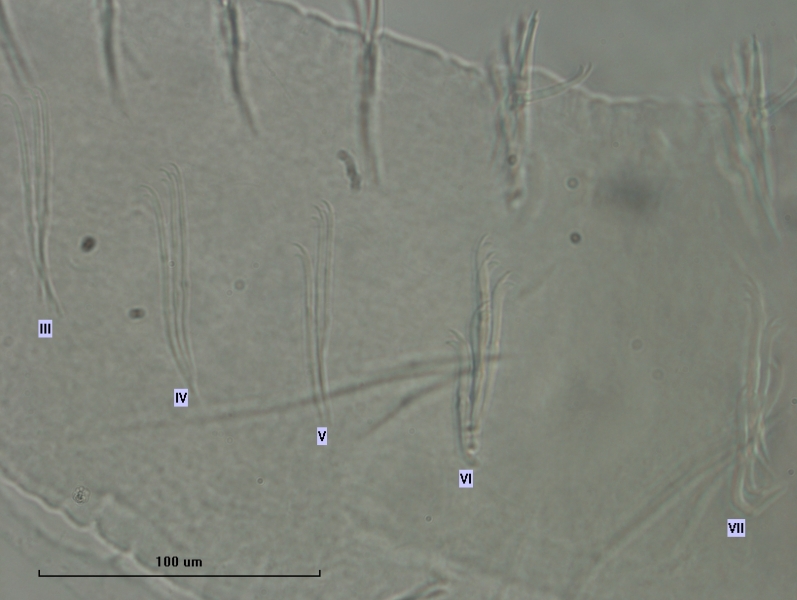Nais simplex
Taxa description
Nais simplex Piguet, 1906 is a freshwater oligochaete worm that is an uncommon oligochaete in the Great Lakes. It is a naidid worm with dorsal bundles beginning in VI and ventral bundles beginning in II, hair chaetae in the dorsal bundles, and without a proboscis. Worms in the genus Nais have 1-2 hair and needle chaetae in each dorsal bundle with simple-pointed or bifid needles; the ventrals usually change between V and VI, often quite dramatically. Anterior ventral chaetae have an upper tooth that is twice as long as the lower, while the posterior ventral chaetae have upper teeth that are equally long or slightly longer than the lower tooth. The needle chaetae are simple-pointed with broad tips, with the nodulus 1/3 distance from the distal end.
Distinguishing features
N. simplex has dorsal bundles with 1-2 hair chaetae and 1-2 simple-pointed needles with broad tips that are about 60 µm. Anterior ventral bundles of II–V have 2–6 chaetae with upper teeth that are about twice as long as the lower tooth. Starting in VI, there are 2-5 variable chaetae per bundle with the upper tooth as long as or slightly longer than the lower tooth. If mature, there are two penial chaetae per bundle.
Habitat
Found widely east of the Mississippi River.
Lake occurrence
Lakes Erie, Huron, Michigan, and Ontario.
Similar species
N. simplex, unlike many of the other Nais species found in the Great Lakes, has simple-pointed needles. It’s most likely to be confused with Nais alpina, which also has simple-pointed needles. The main difference between N. simplex and N. alpina is that the ventrals of N. alpina do not change much between V and VI since the anterior chaetae have the upper tooth twice as long as the lower and the rest are longer than lower, never equal. Ventral bundles all have 3 or 4 to 7 chaetae. The nodulus on needles of N. alpina is in a slightly different spot, 1/4 to 1/5 the distance from the distal end. There are 3 penial chaetae instead of 2 when mature. N. alpina is found in some of the Great Lakes but has not been found in our samples.
N. variabilis could be confused with N. simplex if the needles don’t appear bifid. Oil immersion may be needed to distinguish this feature, so look carefully at all of the needles. The lower tooth of the posterior ventral chaetae is usually much thicker than the lower in N. variabilis but may not be as thick in N. simplex.
N. simplex could also be confused with N. barbata or N. pseudobtusa, which may at first appear as extra hairy versions of N. simplex. N. pseudobtusa has 1–3 hairs and needles and N. barbata has up to 5 hairs and needles. The needles of both are longer and sharper than N. simplex, often measuring around 90 µm, while N. simplex has shorter, broader needles measuring around 60 µm. The nodulus of N. barbata is about halfway toward the distal end instead of 1/3, and N. pseudobtusa has very thin needles that may be so attenuated as to appear hair-like. N. pseudobtusa also differs in the ventral chaetae, which have the upper tooth longer and thinner both anteriorly and posteriorly, compared to N. barbata which has equal teeth posteriorly, and N. simplex which has equal or slightly longer upper teeth. N. barbata is found throughout the Great Lakes, but N. pseudobtusa has not been found in our samples.
Relative size
N. simplex is a small freshwater oligochaete.
Does it have a barcode reference from the Great Lakes?
No, this species does not yet have a barcode reference from the Great Lakes.
References
Kathman, R.D., and R.O. Brinkhurst. 1998. Guide to Freshwater Oligochaetes of North America. pp. 82–83, 40, 80–89.
Hiltunen, J.K., and D.J. Klemm. 1980. A Guide to the Naididae (Annelida: Clitellata: Oligochaeta) of North America. pp. 25–26, 35.




